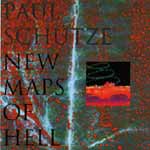new maps of hell
(reissue)
Big Cat 1996
composed and produced by Paul Schütze
Simone De Haan: trombone
Mark Stafford: guitars
Bill McDonald: bass
François Tétaz: percussion
Peter Jones: drums
Peter Neville: percussion
Paul Schütze: keyboards & percussion
1. the eraser
2. topology of a phantom city
3. the velvet horizon
4. eating the first map
5. sacred agents
6. doubts about waking
7. the mutant beautific
8. all that was solid
The first thing Paul Schütze's music tells you is that Hell has no fixed coordinates. Outwardly its audible signs are familiar enough to anyone living in Anytown (above a certain size), anywhere in the world. The smudged palette of noises merges the hubbub of the crowd, construction - sit e clamour and the rising and receding hum of traffic with the musics of the modern Balkanised city's myriad religious rituals and entertainments.
To immerse yourself in the roar of Hell is to strip yourself of all your usual psychic defences. In your newly raw, sensitized state, you can once again live life fully, all senses alert to the experience of new noise, new smells, new sensations, at least for the duration of the trip.
But if Anytown, anywhere in the world at some point appears dismayingly familiar if only from postcards or that once-in-a-lifetime holiday consumer guide, such appearances are deceptive in the extreme, and you are of greatest danger to yourself just when you think you've got the hang of things. At which point you lose control of the city and it begins to take control of you. This is no longer the systematic derangement of the senses attractively practised and preached by Arthur Rimbaud from the Horn of Africa; it's more the destructive erosion of the self documented in Paul Bowles's The Sheltering Sky, where the hidden courtyards of the city's casbahs prove even more hostile to its heroine than the desert winds.
So this is the point of departure of Paul Schütze's New Maps of Hell: the point of separation where the strange begins to pull away from the familiar. His Hell might be applicable to Anytown, but it draws its power from specific detailing that locates it more precisely in one of the burgeoning new interzones of the Pacific Rim. His choice of location reflects not only the fact that heâs an Australian with a deep interest in the musics, specifically percussion, of the Pacific and Indian Oceans. It also attests to the economic and cultural realities of the region.
Originally released in 1992, New Maps of Hell coincided with the West's late recognition of this economic and cultural shift to the Pacific. The pictures accompanying the excited business reports were all computer graphics, skyscrapers and tropical palms. Unsurprisingly, these glowing reports carried no real sense of what it's like to be in such a city, where new money and air-conditioned shopping malls have been grafted on to densely populated streets, and every available slope is the site for a precariously clinging shanty town. For its part, Schütze's music sets you down close to its beating heart. Deploying his percussion-heavy ensemble, including trombone, bass, guitar and keyboards, he creates a dense, thrilling frenzy of sound the equal of Miles Davis's Agharta (recorded live and initially only released in Japan, the state that typifies both the vitality and cultural peculiarities of the new Pacific). The disc begins exotically enough with a dawn call to prayer rising above the mist rolling in from the sea. The piece's one clear voice solemnly intones, " did not say this. I am not here." That's the last clear human statement you'll hear for its duration. Elsewhere a taped Japanese voice, then someone speaking a less familiar language and finally an utterly alien utterance are the coordinates plotting the music's shifts into the dark unknown. And suddenly you can no longer find your way back to the central marketplace where dispersed and desperate peoples forlornly gather to glean the information that might lead them to the open sea. Inevitably, the music loses itself in dirt-ridden back alleys. The darker the alleys, the more menacing the ambiences. Here, silence threatens more than it reassures. And all the time your future is haunted by the single terrifying sound, heard on "Topology of a Phantom City", of chopper blades disappearing into the dusk, conjuring the newsreel image of the last helicopter leaving Vietnam before the fall of Saigon.
The percussion traces the pulses from the centre to the various outlying suburbs where the cityâs ethnic mixes are most apparent. It's not Schütze's intention to homogenise these disparate ethnic musical elements, but to "compose" them into a modern Balkanised city. Immerse yourself in it and soon the sense of heat and filth trapped in the arcs of sound drawn by the trombone and keyboards starts to Balkanise you. By the disc's end, all your certainties have been thoroughly pulled apart.
Biba Kopf, The Hidden Reverse, 1995
recorded at Absolute Studios (engineering Paul Schütze) & ABC Studio 325 (engineering Gary Havrillay).
cover design: Anne-Louise Falson + Paul Schütze
digital mastering: Denis Blackham At Porky's
thanks To Craig Carter field recordings, Gareth Vanderhope atmospheres, Frank Lipsome digital editing, François Tétaz,Garry Havrillay, Base Technology, John Crawford, Australian Broadcasting Corporation, Michael Trugeon & Soundfirm Melbourne.
